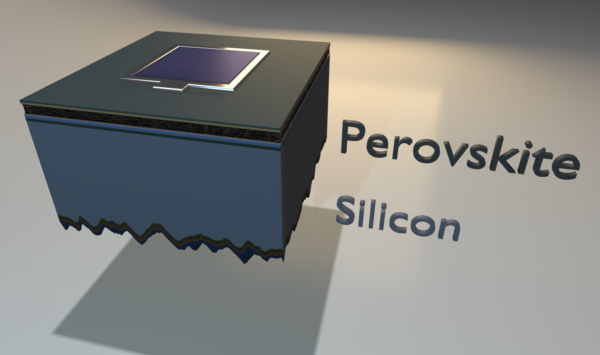A group of scientists at the Helmholtz Zentrum Berlin (HZB) has produced a perovskite/silicon tandem cell measured at 29.15% efficiency, a new world record for the technology.
HZB previously held the efficiency record for PS/Si tandem cell efficiency at 25.5%, before UK/Germany based startup Oxford PV pushed further, producing a 28% efficient cell in late 2018. HZB’s new record has been officially certified by Germany’s Fraunhofer ISE, and the group says it will now be targeting the 30% barrier for this technology.
Optimizing the layers
Key to the group’s achievement were improvements in several of the cell layers. “We developed a special electrode contact layer for this cell in collaboration with the group of Prof. Vytautas Getautis (Kaunas University of Technology), and also improved intermediate layers“, explain Eike Köhnen and Amran Al-Ashouri, doctoral students at HZB.
The two went on to explain that the record breaking cell also featured an improved perovskite composition which increased stability improved the balance of currents delivered by the two cells, and an optimized silicon oxide top layer on the bottom Si cell, which improves optical coupling between the two.

While the cell measures just 1cm² and was produced using laboratory techniques, the group points out the processes used to produce the cell are “suitable in principle for large surface areas”. Without further information, they state that initial tests have shown promising results for vacuum deposition processes to scale up production of these cells.
Pushing for 30%
The next target for the HZB group is to push this efficiency beyond 30% and closer to the technology’s practical limit of around 35%. According to group leader Steve Albrecht, discussions on the best route to achieving this are already underway.
Albrecht’s group at HZB also holds the efficiency record for a perovskite/CIGS tandem cell at 23.26%, and has licensed the technology used in this cell to an unnamed Japanese manufacturer for commercial development.
This content is protected by copyright and may not be reused. If you want to cooperate with us and would like to reuse some of our content, please contact: editors@pv-magazine.com.




Wikipedia gives the “theoretical limiting efficiency” of crystalline silicon cells in sunlight as 29.43%., below the Shockley–Queisser limit of 33.16% applying to a single-junction cell made of an imaginary material with an optimal band gap. We can safely assume that perovskite tandem cells have now surpassed the practically attainable maximum for a plain silicon cell. Commercialisation requires more: a margin over silicon sufficient to justify the extra processing. If we take 23% as the commercial maximum for silicon today, and we need (guessing) a 5% margin on top, the researchers are almost there.
If one can get a cheap, reliable long lasting cell and assemble into modules at that 30% efficiency mark one would have a ‘standard’ 63″ by 39″ solar PV panel that puts out about 320 watts out to about 475 watts in the same sized package. If these folks can get a 35% tandem module to market, it would be right around 560 watts in the same package. For a 410 square foot roof array, it would mean 13.44kWp.
Could we gain light and power by using space cells.
While raising the Efficiency Bar of Solar Cells/Panels is very important….. Total Costs associated with Solar Installations is increasingly moving from Solar Cells/Panels… to “other areas”…. Installation/Support Structures, Assemblies & Components, Labor, Cabling, Equalizing, Storage (Batteries), Chargers/Inverters…. and of course “Paperwork” for this/that Permits, Solar Incentives & Credits; prohibitive Metering, Interconnection and Demand Charges (in place of Credits when installed in Generation Deficient Areas)…. almost amounting to exhtortion…. and lower “home mortgage” level interest rates/financing.
Perhaps the “low hanging fruits” in these areas deserve the same attention as Solar Cell/Panel Efficiency Improvememts…. to lower the TOTAL COST of Solar Installations, reduce ROI durations, etc. and clean up the environmental mess we have or are leaving behind for our children and grandchildren.